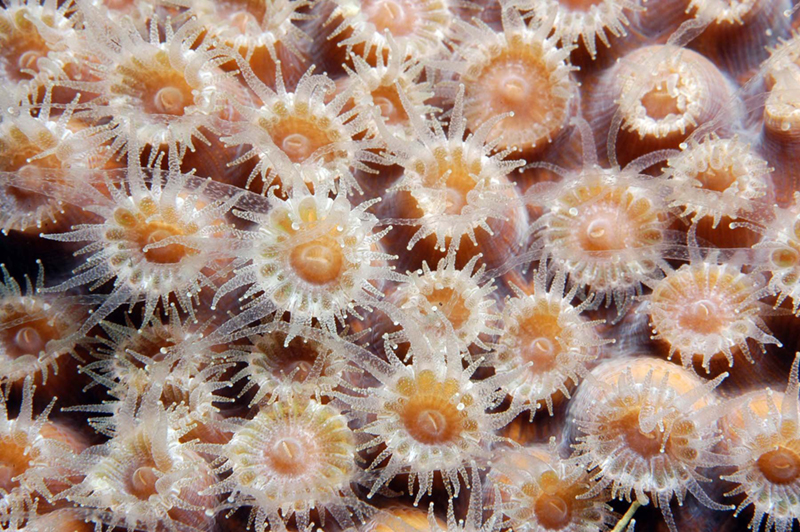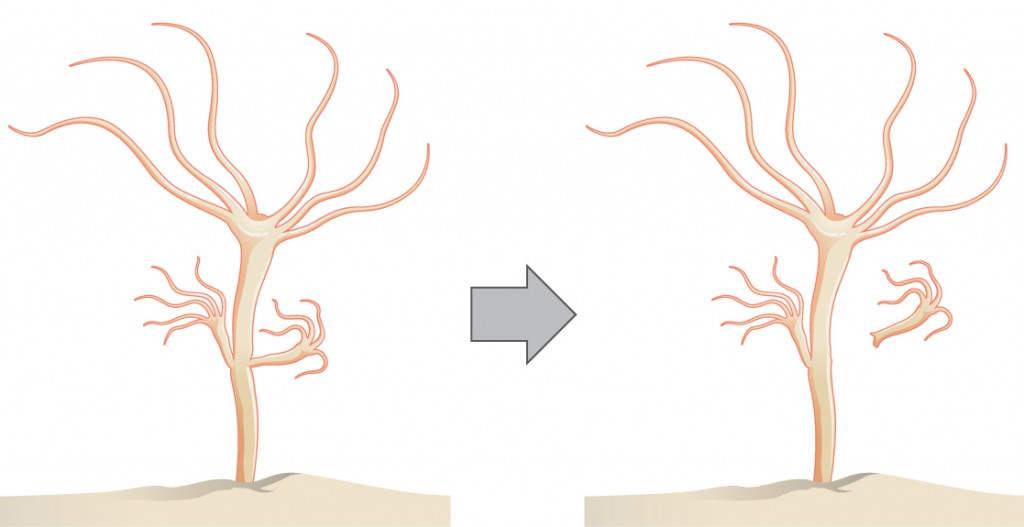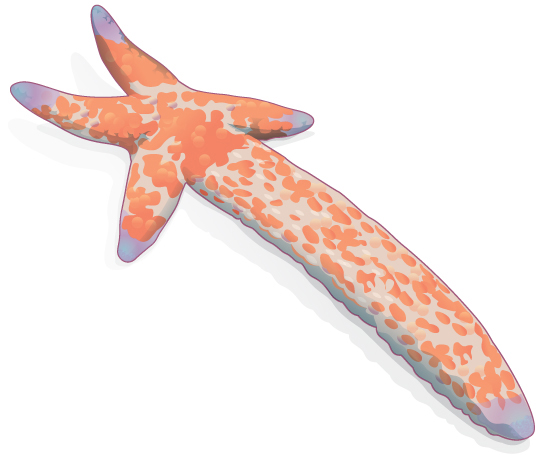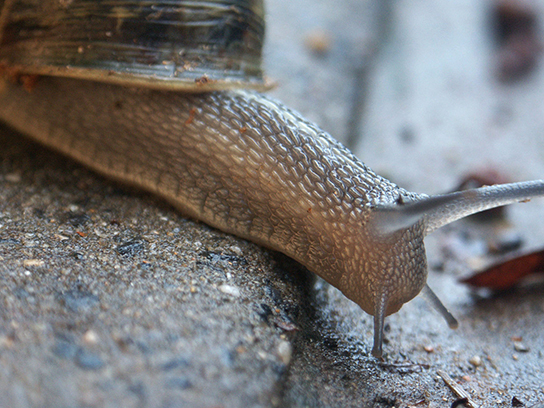Why Would Sexual Selection Be More Advantageous In A Highly Parasitized Population Of Animals?
Chapter 24. Animal Reproduction and Development
24.1. Reproduction Methods
Learning Objectives
By the terminate of this section, you volition be able to:
- Describe advantages and disadvantages of asexual and sexual reproduction
- Hash out asexual reproduction methods
- Discuss sexual reproduction methods
Animals produce offspring through asexual and/or sexual reproduction. Both methods have advantages and disadvantages. Asexual reproduction produces offspring that are genetically identical to the parent considering the offspring are all clones of the original parent. A single private can produce offspring asexually and large numbers of offspring tin be produced quickly. In a stable or anticipated environment, asexual reproduction is an effective means of reproduction because all the offspring will be adapted to that environment. In an unstable or unpredictable environment asexually-reproducing species may be at a disadvantage because all the offspring are genetically identical and may not have the genetic variation to survive in new or different atmospheric condition. On the other mitt, the rapid rates of asexual reproduction may allow for a speedy response to environmental changes if individuals have mutations. An boosted advantage of asexual reproduction is that colonization of new habitats may be easier when an individual does non need to observe a mate to reproduce.
During sexual reproduction the genetic material of two individuals is combined to produce genetically various offspring that differ from their parents. The genetic diversity of sexually produced offspring is thought to requite species a better hazard of surviving in an unpredictable or changing environment. Species that reproduce sexually must maintain 2 unlike types of individuals, males and females, which can limit the ability to colonize new habitats as both sexes must exist nowadays.
Asexual Reproduction
Asexual reproduction occurs in prokaryotic microorganisms (bacteria) and in some eukaryotic single-celled and multi-celled organisms. At that place are a number of means that animals reproduce asexually.
Fission
Fission, also called binary fission, occurs in prokaryotic microorganisms and in some invertebrate, multi-celled organisms. Afterwards a menstruation of growth, an organism splits into ii carve up organisms. Some unicellular eukaryotic organisms undergo binary fission past mitosis. In other organisms, part of the individual separates and forms a second private. This process occurs, for example, in many asteroid echinoderms through splitting of the cardinal disk. Some bounding main anemones and some coral polyps (Figure 24.two) also reproduce through fission.

Budding
Budding is a form of asexual reproduction that results from the outgrowth of a part of a cell or body region leading to a separation from the original organism into two individuals. Budding occurs commonly in some invertebrate animals such as corals and hydras. In hydras, a bud forms that develops into an adult and breaks away from the master trunk, as illustrated in Figure 24.3, whereas in coral budding, the bud does not detach and multiplies as function of a new colony.

Watch a video of a hydra budding.
Fragmentation
Fragmentation is the breaking of the body into 2 parts with subsequent regeneration. If the beast is capable of fragmentation, and the part is big enough, a split private will regrow.
For example, in many sea stars, asexual reproduction is accomplished past fragmentation. Figure 24.four illustrates a sea star for which an arm of the individual is broken off and regenerates a new ocean star. Fisheries workers have been known to attempt to kill the sea stars eating their clam or oyster beds past cutting them in one-half and throwing them back into the ocean. Unfortunately for the workers, the two parts tin each regenerate a new half, resulting in twice as many body of water stars to prey upon the oysters and clams. Fragmentation likewise occurs in annelid worms, turbellarians, and poriferans.

Note that in fragmentation, there is generally a noticeable deviation in the size of the individuals, whereas in fission, two individuals of gauge size are formed.
Parthenogenesis
Parthenogenesis is a form of asexual reproduction where an egg develops into a consummate individual without being fertilized. The resulting offspring tin be either haploid or diploid, depending on the process and the species. Parthenogenesis occurs in invertebrates such as h2o flees, rotifers, aphids, stick insects, some ants, wasps, and bees. Bees use parthenogenesis to produce haploid males (drones) and diploid females (workers). If an egg is fertilized, a queen is produced. The queen bee controls the reproduction of the hive bees to regulate the type of bee produced.
Some vertebrate animals—such equally sure reptiles, amphibians, and fish—besides reproduce through parthenogenesis. Although more common in plants, parthenogenesis has been observed in animal species that were segregated by sex activity in terrestrial or marine zoos. Two female Komodo dragons, a hammerhead shark, and a blacktop shark accept produced parthenogenic immature when the females have been isolated from males.
Sexual Reproduction
Sexual reproduction is the combination of (commonly haploid) reproductive cells from 2 individuals to form a third (usually diploid) unique offspring. Sexual reproduction produces offspring with novel combinations of genes. This can be an adaptive advantage in unstable or unpredictable environments. As humans, nosotros are used to thinking of animals as having two separate sexes—male and female—determined at formulation. Even so, in the beast kingdom, at that place are many variations on this theme.
Hermaphroditism
Hermaphroditism occurs in animals where 1 private has both male and female reproductive parts. Invertebrates such equally earthworms, slugs, tapeworms and snails, shown in Figure 24.5, are often hermaphroditic. Hermaphrodites may cocky-fertilize or may mate with some other of their species, fertilizing each other and both producing offspring. Self fertilization is common in animals that have express mobility or are not motile, such as barnacles and clams.

Sex Determination
Mammalian sex determination is adamant genetically past the presence of X and Y chromosomes. Individuals homozygous for X (XX) are female and heterozygous individuals (XY) are male person. The presence of a Y chromosome causes the development of male characteristics and its absence results in female person characteristics. The XY system is as well found in some insects and plants.
Avian sex determination is dependent on the presence of Z and West chromosomes. Homozygous for Z (ZZ) results in a male and heterozygous (ZW) results in a female. The Westward appears to exist essential in determining the sex activity of the individual, similar to the Y chromosome in mammals. Some fish, crustaceans, insects (such as butterflies and moths), and reptiles use this organization.
The sex of some species is non determined by genetics simply by some aspect of the environment. Sex decision in some crocodiles and turtles, for example, is frequently dependent on the temperature during critical periods of egg development. This is referred to as environmental sex determination, or more than specifically every bit temperature-dependent sex determination. In many turtles, cooler temperatures during egg incubation produce males and warm temperatures produce females. In some crocodiles, moderate temperatures produce males and both warm and cool temperatures produce females. In some species, sex is both genetic- and temperature-dependent.
Individuals of some species change their sex during their lives, alternating between male person and female. If the private is female person first, it is termed protogyny or "first female," if it is male kickoff, its termed protandry or "beginning male." Oysters, for example, are born male person, abound, and become female and lay eggs; some oyster species alter sex multiple times.
Summary
Reproduction may be asexual when 1 individual produces genetically identical offspring, or sexual when the genetic material from two individuals is combined to produce genetically various offspring. Asexual reproduction occurs through fission, budding, and fragmentation. Sexual reproduction may mean the joining of sperm and eggs within animals' bodies or it may hateful the release of sperm and eggs into the environment. An private may be one sex, or both; it may start out every bit ane sex and switch during its life, or information technology may stay male person or female.
Exercises
- Which form of reproduction is thought to exist best in a stable environment?
- asexual
- sexual
- budding
- parthenogenesis
- Which grade of reproduction can result from impairment to the original animate being?
- asexual
- fragmentation
- budding
- parthenogenesis
- Which course of reproduction is useful to an animal with fiddling mobility that reproduces sexually?
- fission
- budding
- parthenogenesis
- hermaphroditism
- Genetically unique individuals are produced through ________.
- sexual reproduction
- parthenogenesis
- budding
- fragmentation
- Why is sexual reproduction useful if only half the animals can produce offspring and two carve up cells must be combined to form a tertiary?
- What determines which sex will result in offspring of birds and mammals?
Answers
- A
- B
- D
- A
- Sexual reproduction produces a new combination of genes in the offspring that may better enable them to survive changes in the environment and assist in the survival of the species.
- The presence of the Due west chromosome in birds determines femaleness and the presence of the Y chromosome in mammals determines maleness. The absenteeism of those chromosomes and the homogeneity of the offspring (ZZ or Xx) leads to the evolution of the other sex.
Glossary
- asexual reproduction
- form of reproduction that produces offspring that are genetically identical to the parent
- budding
- form of asexual reproduction that results from the outgrowth of a part of a cell leading to a separation from the original animal into two individuals
- fission
- (as well, binary fission) method by which multicellular organisms increment in size or asexual reproduction in which a unicellular organism splits into ii separate organisms by mitosis
- fragmentation
- cutting or fragmenting of the original animal into parts and the growth of a split up animal from each office
- hermaphroditism
- country of having both male and female person reproductive parts within the same individual
- parthenogenesis
- form of asexual reproduction where an egg develops into a complete individual without being fertilized
- sexual reproduction
- mixing of genetic cloth from ii individuals to produce genetically unique offspring
Source: https://opentextbc.ca/biology/chapter/24-1-reproduction-methods/
Posted by: rayandoess.blogspot.com

0 Response to "Why Would Sexual Selection Be More Advantageous In A Highly Parasitized Population Of Animals?"
Post a Comment